Abstract
Cellular resistance to heavy metal cytotoxicity in most species is mediated by the binding of metal ions either to a cysteine-rich polypeptide in the metallothionein family or to short cysteine-containing gamma-glutamyl peptides. One of these metal binding systems has been found in most organisms studied. However, the yeast Candida (Torulopsis) glabrata expresses both metallothionein and the gamma-glutamyl peptides for metal detoxification, and each system is regulated in a metal-specific manner. Exposure of C. glabrata to copper salts stimulates formation of two metallothionein-like polypeptides with a cysteine content of 30 mol% and the repeated sequence Cys-Xaa-Cys. The cells synthesize gamma-glutamyl peptides upon exposure to cadmium salts. Penta- and tetrapeptides that form a cadmium-thiolate cluster in a peptide oligomer containing labile sulfur are synthesized.
Full text
PDF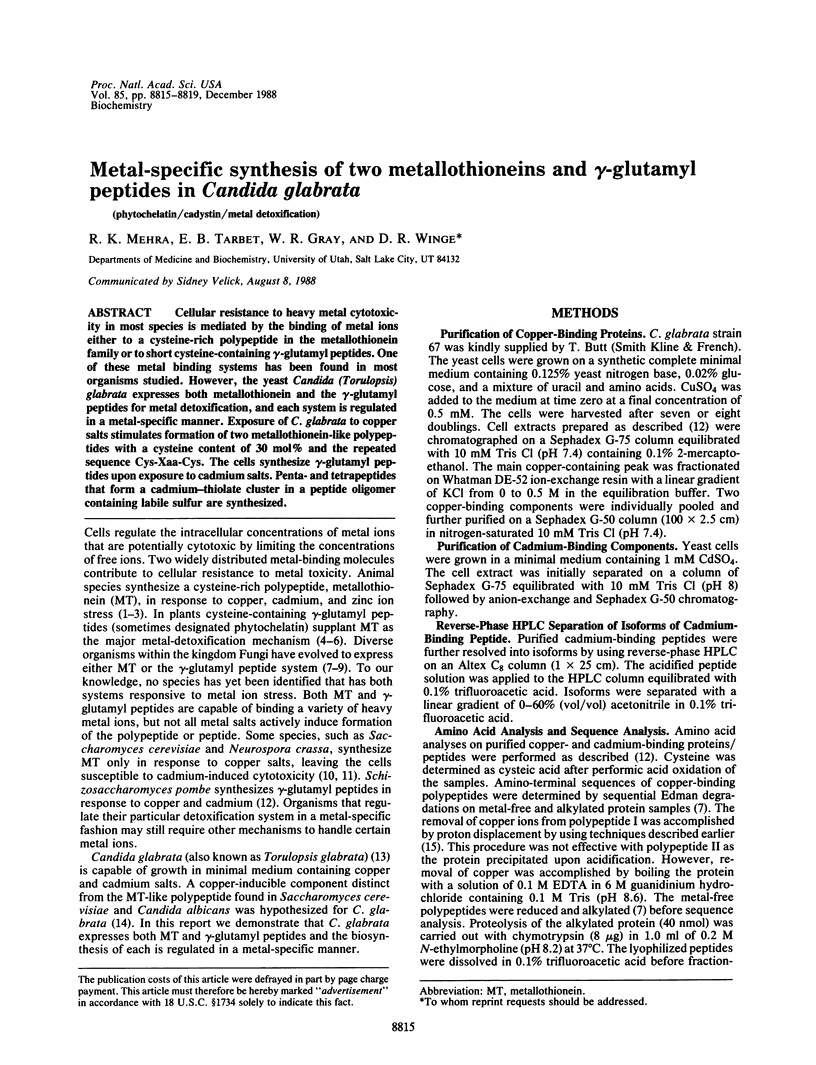
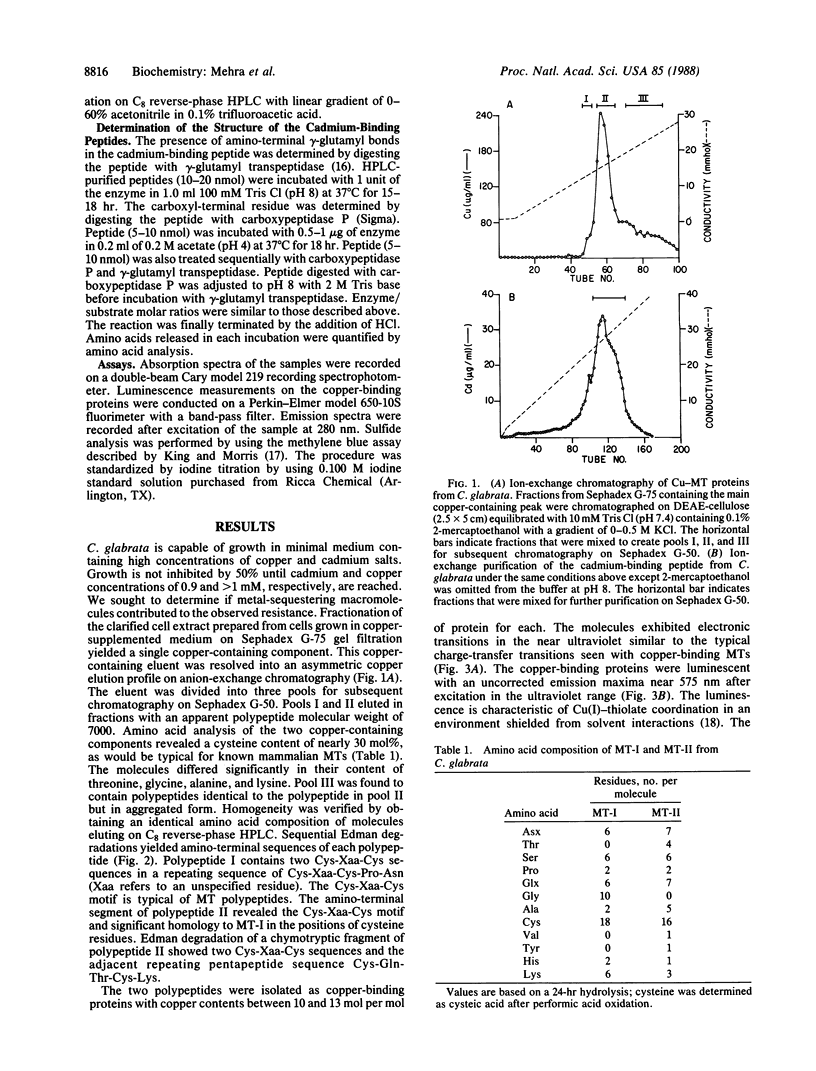
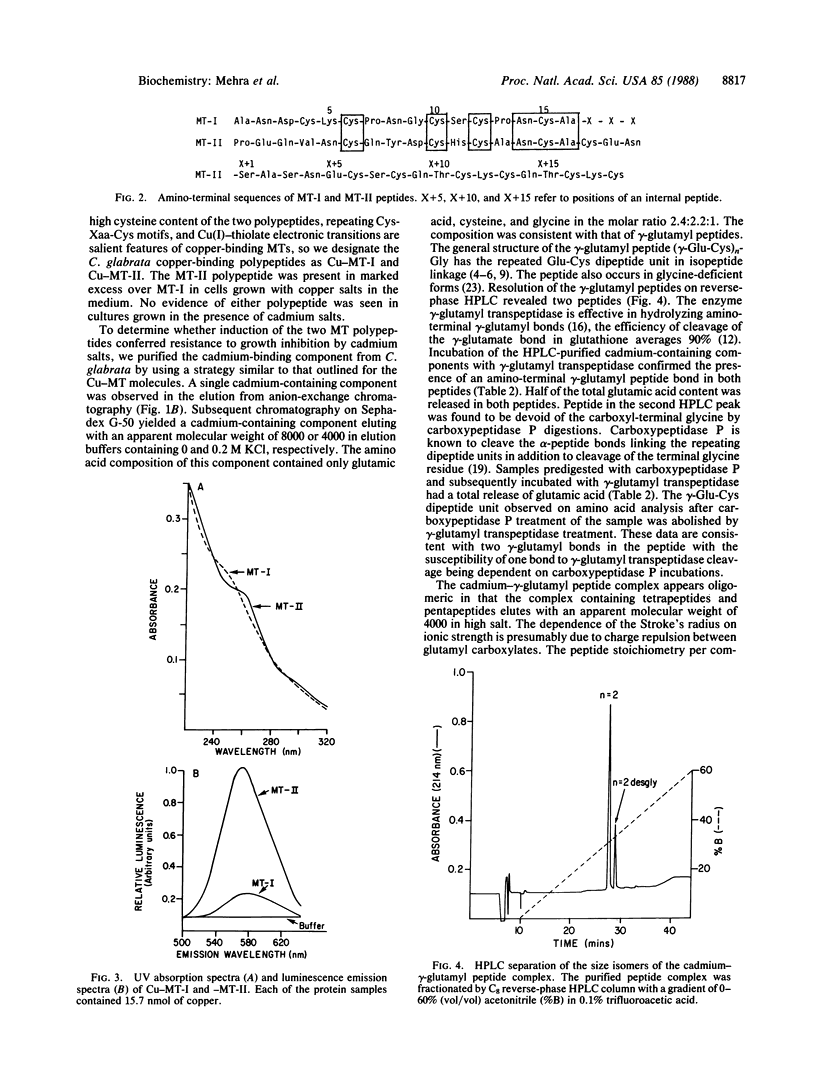
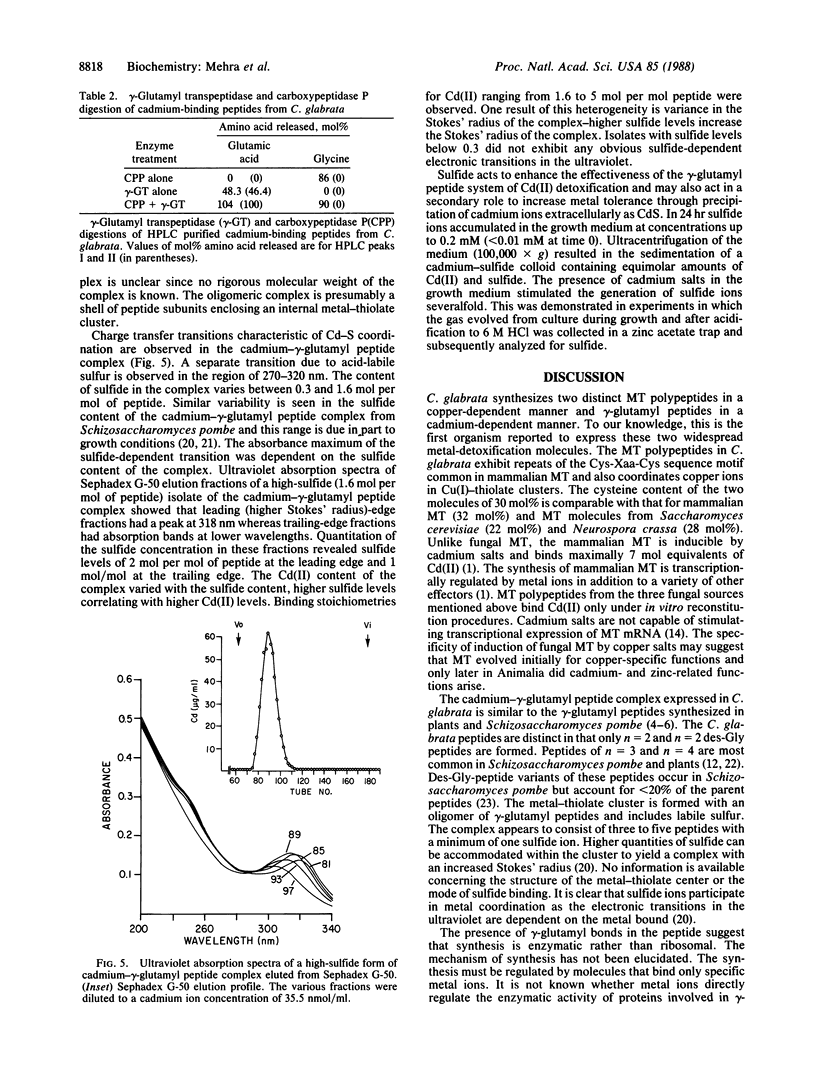
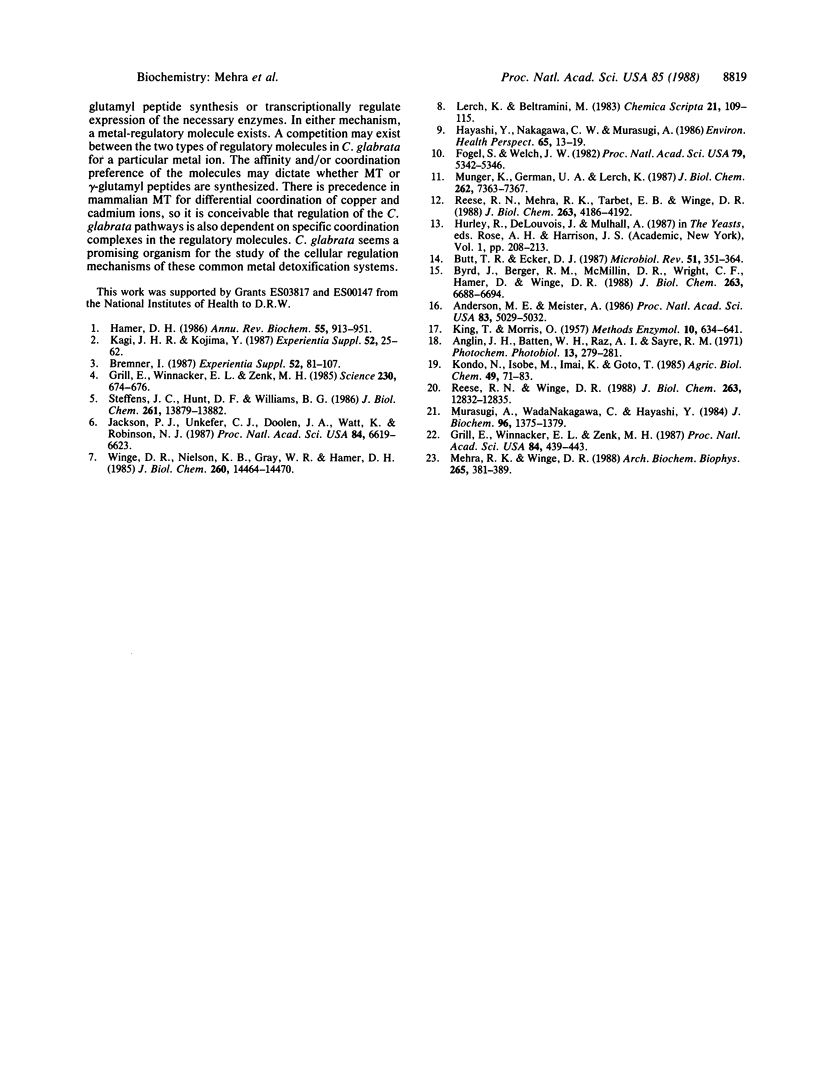
Selected References
These references are in PubMed. This may not be the complete list of references from this article.
- Anderson M. E., Meister A. Inhibition of gamma-glutamyl transpeptidase and induction of glutathionuria by gamma-glutamyl amino acids. Proc Natl Acad Sci U S A. 1986 Jul;83(14):5029–5032. doi: 10.1073/pnas.83.14.5029. [DOI] [PMC free article] [PubMed] [Google Scholar]
- Bremner I. Nutritional and physiological significance of metallothionein. Experientia Suppl. 1987;52:81–107. doi: 10.1007/978-3-0348-6784-9_5. [DOI] [PubMed] [Google Scholar]
- Butt T. R., Ecker D. J. Yeast metallothionein and applications in biotechnology. Microbiol Rev. 1987 Sep;51(3):351–364. doi: 10.1128/mr.51.3.351-364.1987. [DOI] [PMC free article] [PubMed] [Google Scholar]
- Byrd J., Berger R. M., McMillin D. R., Wright C. F., Hamer D., Winge D. R. Characterization of the copper-thiolate cluster in yeast metallothionein and two truncated mutants. J Biol Chem. 1988 May 15;263(14):6688–6694. [PubMed] [Google Scholar]
- Fogel S., Welch J. W. Tandem gene amplification mediates copper resistance in yeast. Proc Natl Acad Sci U S A. 1982 Sep;79(17):5342–5346. doi: 10.1073/pnas.79.17.5342. [DOI] [PMC free article] [PubMed] [Google Scholar]
- Grill E., Winnacker E. L., Zenk M. H. Phytochelatins, a class of heavy-metal-binding peptides from plants, are functionally analogous to metallothioneins. Proc Natl Acad Sci U S A. 1987 Jan;84(2):439–443. doi: 10.1073/pnas.84.2.439. [DOI] [PMC free article] [PubMed] [Google Scholar]
- Grill E., Winnacker E. L., Zenk M. H. Phytochelatins: the principal heavy-metal complexing peptides of higher plants. Science. 1985 Nov 8;230(4726):674–676. doi: 10.1126/science.230.4726.674. [DOI] [PubMed] [Google Scholar]
- Hamer D. H. Metallothionein. Annu Rev Biochem. 1986;55:913–951. doi: 10.1146/annurev.bi.55.070186.004405. [DOI] [PubMed] [Google Scholar]
- Hayashi Y., Nakagawa C. W., Murasugi A. Unique properties of Cd-binding peptides induced in fission yeast, Schizosaccharomyces pombe. Environ Health Perspect. 1986 Mar;65:13–19. doi: 10.1289/ehp.866513. [DOI] [PMC free article] [PubMed] [Google Scholar]
- Jackson P. J., Unkefer C. J., Doolen J. A., Watt K., Robinson N. J. Poly(gamma-glutamylcysteinyl)glycine: its role in cadmium resistance in plant cells. Proc Natl Acad Sci U S A. 1987 Oct;84(19):6619–6623. doi: 10.1073/pnas.84.19.6619. [DOI] [PMC free article] [PubMed] [Google Scholar]
- Kägi J. H., Kojima Y. Chemistry and biochemistry of metallothionein. Experientia Suppl. 1987;52:25–61. doi: 10.1007/978-3-0348-6784-9_3. [DOI] [PubMed] [Google Scholar]
- Mehra R. K., Winge D. R. Cu(I) binding to the Schizosaccharomyces pombe gamma-glutamyl peptides varying in chain lengths. Arch Biochem Biophys. 1988 Sep;265(2):381–389. doi: 10.1016/0003-9861(88)90141-5. [DOI] [PubMed] [Google Scholar]
- Murasugi A., Wada Nakagawa C., Hayashi Y. Formation of cadmium-binding peptide allomorphs in fission yeast. J Biochem. 1984 Nov;96(5):1375–1379. doi: 10.1093/oxfordjournals.jbchem.a134965. [DOI] [PubMed] [Google Scholar]
- Münger K., Germann U. A., Lerch K. The Neurospora crassa metallothionein gene. Regulation of expression and chromosomal location. J Biol Chem. 1987 May 25;262(15):7363–7367. [PubMed] [Google Scholar]
- Reese R. N., Mehra R. K., Tarbet E. B., Winge D. R. Studies on the gamma-glutamyl Cu-binding peptide from Schizosaccharomyces pombe. J Biol Chem. 1988 Mar 25;263(9):4186–4192. [PubMed] [Google Scholar]
- Reese R. N., Winge D. R. Sulfide stabilization of the cadmium-gamma-glutamyl peptide complex of Schizosaccharomyces pombe. J Biol Chem. 1988 Sep 15;263(26):12832–12835. [PubMed] [Google Scholar]
- Steffens J. C., Hunt D. F., Williams B. G. Accumulation of non-protein metal-binding polypeptides (gamma-glutamyl-cysteinyl)n-glycine in selected cadmium-resistant tomato cells. J Biol Chem. 1986 Oct 25;261(30):13879–13882. [PubMed] [Google Scholar]
- Winge D. R., Nielson K. B., Gray W. R., Hamer D. H. Yeast metallothionein. Sequence and metal-binding properties. J Biol Chem. 1985 Nov 25;260(27):14464–14470. [PubMed] [Google Scholar]


